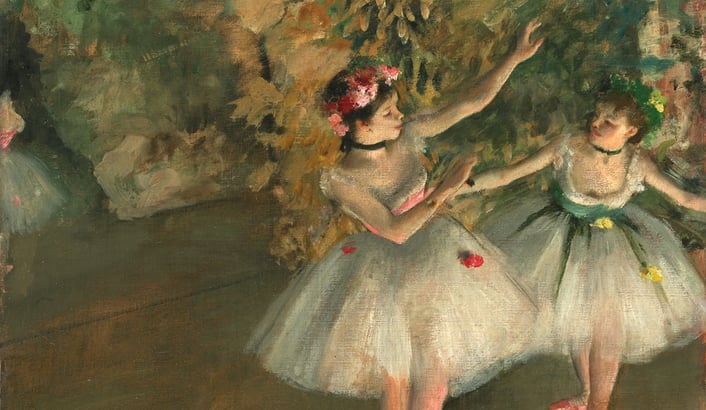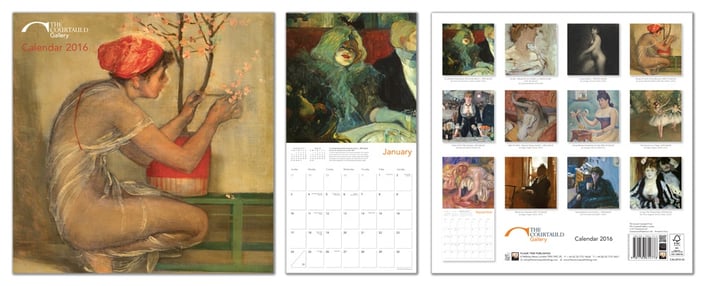Impressionism emerged during the second half of the nineteenth century, at a time when the Académie des Beaux-Arts was largely in charge of what French art, its content and its style should look like. The Académie favoured traditional values and conventions and they were quick to dismiss Impressionist painters' work because of the latters' disinterest for realism and detailed accuracy. Monet, Renoir and company are known to have taken more interest in perception than description. They preferred landscapes to historical scenes and contemporary life to mythology. Among the Impressionists' most recurrent subjects is the female form, which we will be taking a closer look at in today's blog.

Pretty Things
We have already discussed Edgar Degas' petits rats in a previous blog, so it is only fitting that we should begin with his work. Degas' depictions of ballet dancers at practice are characteristic of the voyeurism that transpires through many Impressionist paintings: they take on the point of view of a man peering at women as though they were on display. His Two Dancers on a Stage (1874) is a perfect example of this. The girls are young, presumably from a middle or upper class background, and surrounded by signs of innocence and purity: they are wearing white, child-like tutus and flowers in their hair – pink and green are colours associated with youth, expectation and fertility. The ballerina is a significant symbol in itself although Degas was more interested in studying movement and posture than in conveying a romantic notion that was already a thing of the past.
Dancing was an activity that was – and to some extent it still is – largely associated with femininity.
Edouard Manet's artwork Au Bal – Marguerite de Conflans en Toilette de Bal (1870–80) was never finished and perhaps it is this very incompleteness that makes it so intriguing. His somewhat irregular, blurry brushstrokes give the painting a lively quality and a great sense of movement. He painted Marguerite's skin and gown with the same shades as the background, thus strengthening the idea that she fits perfectly in the atmosphere of the ballroom. Again we see her through the eyes of a male voyeur, maybe in the process of choosing a partner for a potential marital life.
Mothers and Wives
Not all Impressionist painters were men though, and female artists give us a different, probably more accurate perspective on the matter. In The Cradle (1872), Berthe Morisot immortalized her sister Edma in her first days as a mother. The first interesting thing to note is that, where men would often paint outdoor scenes, most paintings by women depicted domestic interiors. The two sisters were very close and had trained as painters together. Edma's love for her child is evident in her gaze and in the way she holds the canopy as though to protect her daughter. Still, there is a sense of melancholy to The Cradle, maybe due to her having to give up painting after her marriage to concentrate on the needs of her family, as social constraints required of women at the time.
Men saw things in a very different light; some of the most interesting Impressionist pictures are the ones that offer us a glimpse of these artists' lives in a time that seems both familiar and utterly estranged from us. Pierre-Auguste Renoir's Luncheon of the Boating Party (1880–81) is perhaps the most well known of those slices of late nineteenth century life. The Luncheon is overflowing with implied relationships between its subjects: at the centre of the scene, for instance, one look is enough to perceive the signs of a burgeoning love triangle. The painting is also particularly telling about the vision men had of their female contemporaries, and about the dynamics between members of the two genders. Of the five female characters scattered across the scene only two are not staring at a man; the first is blushing and averting her eyes from the overwhelming attention of the two men coveting her, the second was modelled after Aline Charignot who was to be Renoir's wife. Aline is instead staring at a puppy – a very domestic symbol.
Depth in Shallowness
But Impressionist painters did not only see their female contemporaries as nice things to look at. Several paintings actually show a certain compassion on their part even though they may not have done much to change the way things were. In Young Girl with a Cherry Blossom (1867–72), James Abbott McNeill Whistler painted his character tending to the eponymous cherry blossom and one cannot help but associate the two together. The girl's hat and her lips are the same red as the pot where the shrub takes its roots, and the skin tone of her face is a reminder of the colour of the flowers themselves. In the end, the girl's place in society is the same as the flower's role in a living room: she is beautiful, delicate, and precious in appearance but ultimately her function is decorative and no one takes any interest in what thoughts might be passing through her head.
Another view of women from the perspective of Impressionist painters is shown in Edouard Manet's Le Déjeuner sur l'Herbe (1862–63), a picture that caused quite the scandal when it was first shown in Paris. The two male characters are wearing modern, fashionable clothes and are enjoying a vacation from the city life. One of them is holding a wooden cane, a very civilized attribute. In contrast, the women are blending in the pastoral scenery; one is bathing in the background and the other is sitting naked in the grass. Although she is sharing the space with the men she is set apart from them through her self-awareness; she is not showing any kind of shyness, embracing her connection with nature and staring right back at the onlooker, defying us to try and tell her how she should behave.
In the early days of the movement in France, the Académie des Beaux-Arts rejected most Impressionist paintings submitted to the juried art show that was held every year at the prestigious Salon de Paris. Fortunately, it occurred to Emperor Napoleon III that maybe people should be allowed to think for themselves and the Salon des Refusés (Salon of the Refused) was organized. Many of the people who attended didn't think they would end up taking the artwork seriously but, ironically enough, the Refusés ended up being more successful than the usual Salon exhibit.
If you're as entranced as we are by the paintings of the Impressionist movement and their depictions of women, you should take a look at our 2016 Courtauld Gallery calendar; you can purchase it on our website or on Amazon.
Links
- Take a look at Ada Pinkston's very interesting website on Impressionism and gender.
- Here's Dr Jeanne S.M. Villette's fascinating take on Impressionism: Class and Gender via the Art History Unstuffed website.




